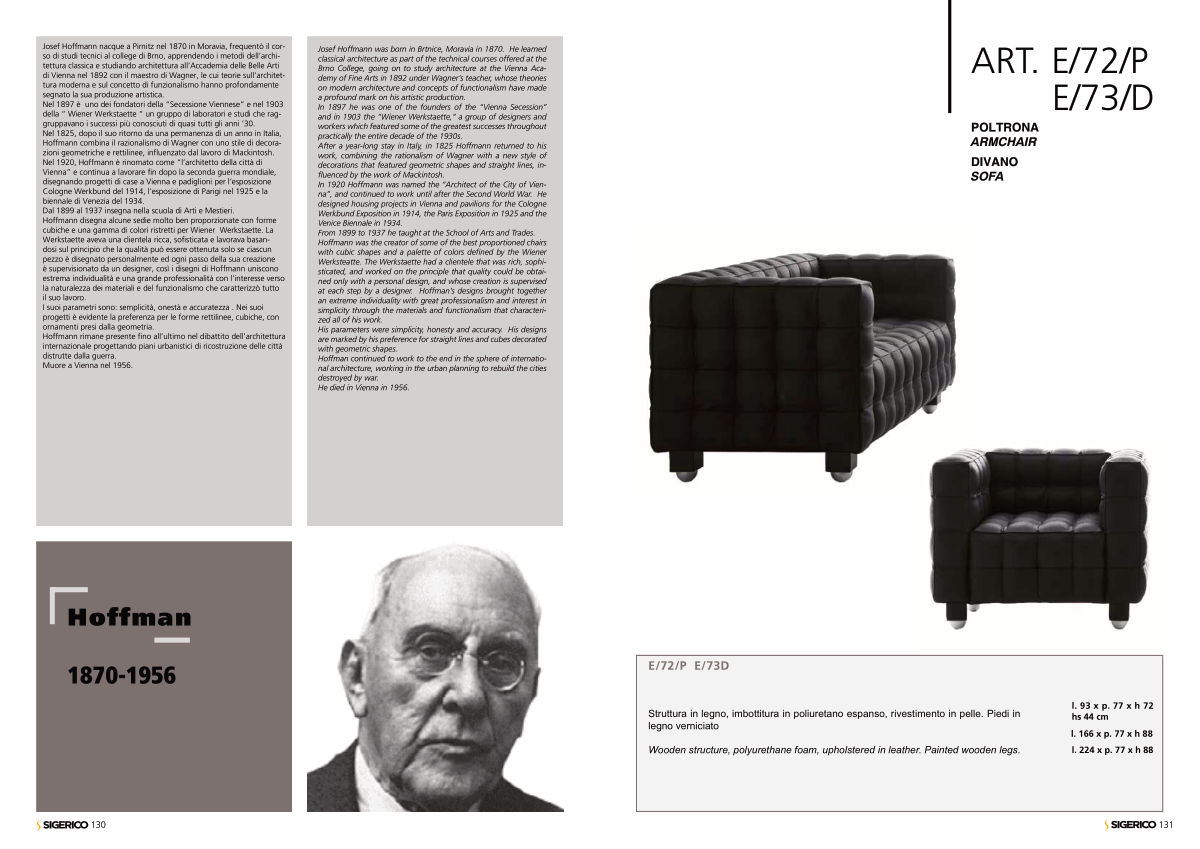Hoffman
1870-1956
Josef Hoffmann nacque a Pirnitz nel 1870 in Moravia, frequentò il cor-
so di studi tecnici al college di Brno, apprendendo i metodi dell’archi-
tettura classica e studiando architettura all’Accademia delle Belle Arti
di Vienna nel 1892 con il maestro di Wagner, le cui teorie sull’architet-
tura moderna e sul concetto di funzionalismo hanno profondamente
segnato la sua produzione artistica.
Nel 1897 è uno dei fondatori della “Secessione Viennese” e nel 1903
della “ Wiener Werkstaette “ un gruppo di laboratori e studi che rag-
gruppavano i successi più conosciuti di quasi tutti gli anni ’30.
Nel 1825, dopo il suo ritorno da una permanenza di un anno in Italia,
Hoffmann combina il razionalismo di Wagner con uno stile di decora-
zioni geometriche e rettilinee, influenzato dal lavoro di Mackintosh.
Nel 1920, Hoffmann è rinomato come “l’architetto della città di
Vienna” e continua a lavorare fin dopo la seconda guerra mondiale,
disegnando progetti di case a Vienna e padiglioni per l’esposizione
Cologne Werkbund del 1914, l’esposizione di Parigi nel 1925 e la
biennale di Venezia del 1934.
Dal 1899 al 1937 insegna nella scuola di Arti e Mestieri.
Hoffmann disegna alcune sedie molto ben proporzionate con forme
cubiche e una gamma di colori ristretti per Wiener Werkstaette. La
Werkstaette aveva una clientela ricca, sofisticata e lavorava basan-
dosi sul principio che la qualità può essere ottenuta solo se ciascun
pezzo è disegnato personalmente ed ogni passo della sua creazione
è supervisionato da un designer, così i disegni di Hoffmann uniscono
estrema individualità e una grande professionalità con l’interesse verso
la naturalezza dei materiali e del funzionalismo che caratterizzò tutto
il suo lavoro.
I suoi parametri sono: semplicità, onestà e accuratezza . Nei suoi
progetti è evidente la preferenza per le forme rettilinee, cubiche, con
ornamenti presi dalla geometria.
Hoffmann rimane presente fino all’ultimo nel dibattito dell’architettura
internazionale progettando piani urbanistici di ricostruzione delle città
distrutte dalla guerra.
Muore a Vienna nel 1956.
Josef Hoffmann was born in Brtnice, Moravia in 1870. He learned
classical architecture as part of the technical courses offered at the
Brno College, going on to study architecture at the Vienna Aca-
demy of Fine Arts in 1892 under Wagner’s teacher, whose theories
on modern architecture and concepts of functionalism have made
a profound mark on his artistic production.
In 1897 he was one of the founders of the “Vienna Secession”
and in 1903 the “Wiener Werkstaette,” a group of designers and
workers which featured some of the greatest successes throughout
practically the entire decade of the 1930s.
After a year-long stay in Italy, in 1825 Hoffmann returned to his
work, combining the rationalism of Wagner with a new style of
decorations that featured geometric shapes and straight lines, in-
fluenced by the work of Mackintosh.
In 1920 Hoffmann was named the “Architect of the City of Vien-
na”, and continued to work until after the Second World War. He
designed housing projects in Vienna and pavilions for the Cologne
Werkbund Exposition in 1914, the Paris Exposition in 1925 and the
Venice Biennale in 1934.
From 1899 to 1937 he taught at the School of Arts and Trades.
Hoffmann was the creator of some of the best proportioned chairs
with cubic shapes and a palette of colors defined by the Wiener
Werksteatte. The Werkstaette had a clientele that was rich, sophi-
sticated, and worked on the principle that quality could be obtai-
ned only with a personal design, and whose creation is supervised
at each step by a designer. Hoffman’s designs brought together
an extreme individuality with great professionalism and interest in
simplicity through the materials and functionalism that characteri-
zed all of his work.
His parameters were simplicity, honesty and accuracy. His designs
are marked by his preference for straight lines and cubes decorated
with geometric shapes.
Hoffman continued to work to the end in the sphere of internatio-
nal architecture, working in the urban planning to rebuild the cities
destroyed by war.
He died in Vienna in 1956.
ART. E/72/P
E/73/D
POLTRONA
ARMCHAIR
DIVANO
SOFA
l. 93 x p. 77 x h 72
hs 44 cm
l. 166 x p. 77 x h 88
l. 224 x p. 77 x h 88
Struttura in legno, imbottitura in poliuretano espanso, rivestimento in pelle. Piedi in
legno verniciato
Wooden structure, polyurethane foam, upholstered in leather. Painted wooden legs.
131
130
E/72/P E/73D


